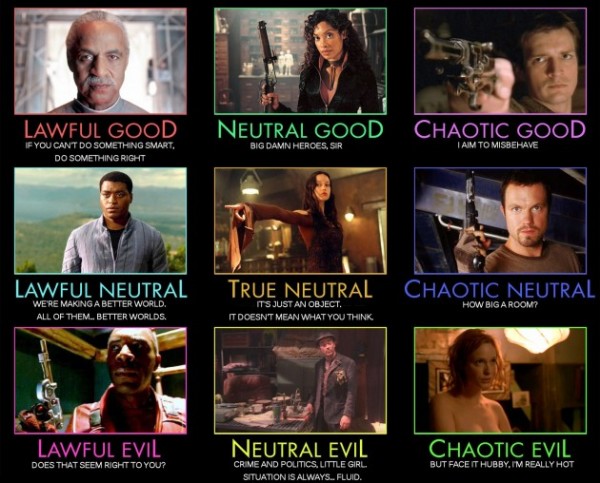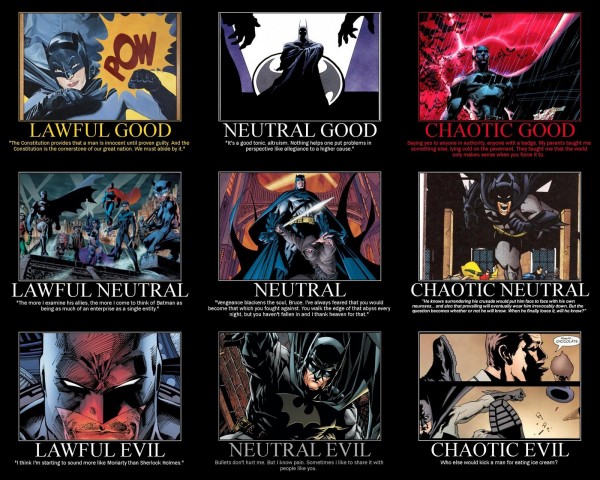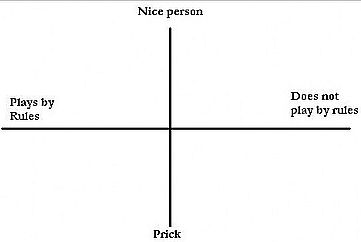
I love personality tests. There’s something immensely satisfying about putting yourself on a grid that tells you something new and insightful about yourself and the people around you. My personal favorite is the Meyers-Briggs test (I’m an ENTP), but I like playing around with others as well.
Character alignment is what you get when you combine fictional characters with the role they’re supposed to play in the story. It’s a way to categorize the different ways they react to problems and ethical dilemmas, and to see which are inclined to be enemies and which are inclined to be allies.
These systems initially arose out of RPG systems like Dungeons and Dragons, which use numbers, charts, and statistics to turn a story into a playable game. There are many different kinds of alignments, but the most well-known is probably the one used by D&D, which charts characters along a good-evil axis and a lawful-chaotic axis. In practice, the result looks a little like this:
Of course, that’s a very simplified version. The tvtropes page goes into much greater depth, but I’ve personally found that this page right here does a much better job explaining the concepts behind the chart.
The horizontal axis, law vs. chaos, describes how much the character values order and authority vs. their own independence and freedom. Lawful characters value honor and obedience, while chaotic characters value innovation and rebelliousness. Characters who are neutral with regards to law and chaos generally respect authority, but put their own interests first and go against the established norms when that’s the best way to further their own ends.
The vertical axis, good vs. evil, describes how well (or poorly) characters tend to treat other people. Good characters are altruistic and make sacrifices to protect the defenseless, whereas evil characters will kill, rob, or torture the innocent simply for the evulz. Characters who are neutral with regards to good and evil don’t like to hurt others, but are not above pursuing questionable means to achieve their own goals.
Put together, the alignments create a 9-square chart, like the one at the top of the post. While it’s certainly not obligatory to fill every slot, doing so can add a greater degree of depth to your story, as it certainly did with Firefly.
As with any formula, however, there is danger in holding too closely to the chart and becoming inflexible. In real life, people switch alignments all the time, just as personalities can change and evolve (in high school, for example, I was an INTP). Not only that, but some characters even fulfill all the possible roles, depending on the incarnation and the story.

The point is, character alignment is just a tool, not a hard-and-fast rule that needs to be used with every story. If it’s a helpful way to think about your characters and set them up with interesting conflicts, great. If not, don’t sweat it; Homer and Shakespeare were telling great stories long before this chart.
I’m going to be going overseas soon, so I expect my internet access is going to be spotty for the next couple of months. Because of that, I’m going to write up a bunch of Trope Tuesday posts on each of the nine alignments and schedule them to post automatically. So stay tuned for more!

These remind me of Dungeons and Dragons a long time ago. I wish I’d had these charts available back then. It would have made it so much easier to figure out what is meant by what.
I never played D&D, so I’m not sure how that was, but I’ll take your word for it. If I were GMing a game, I’d certainly be using this kind of a chart.